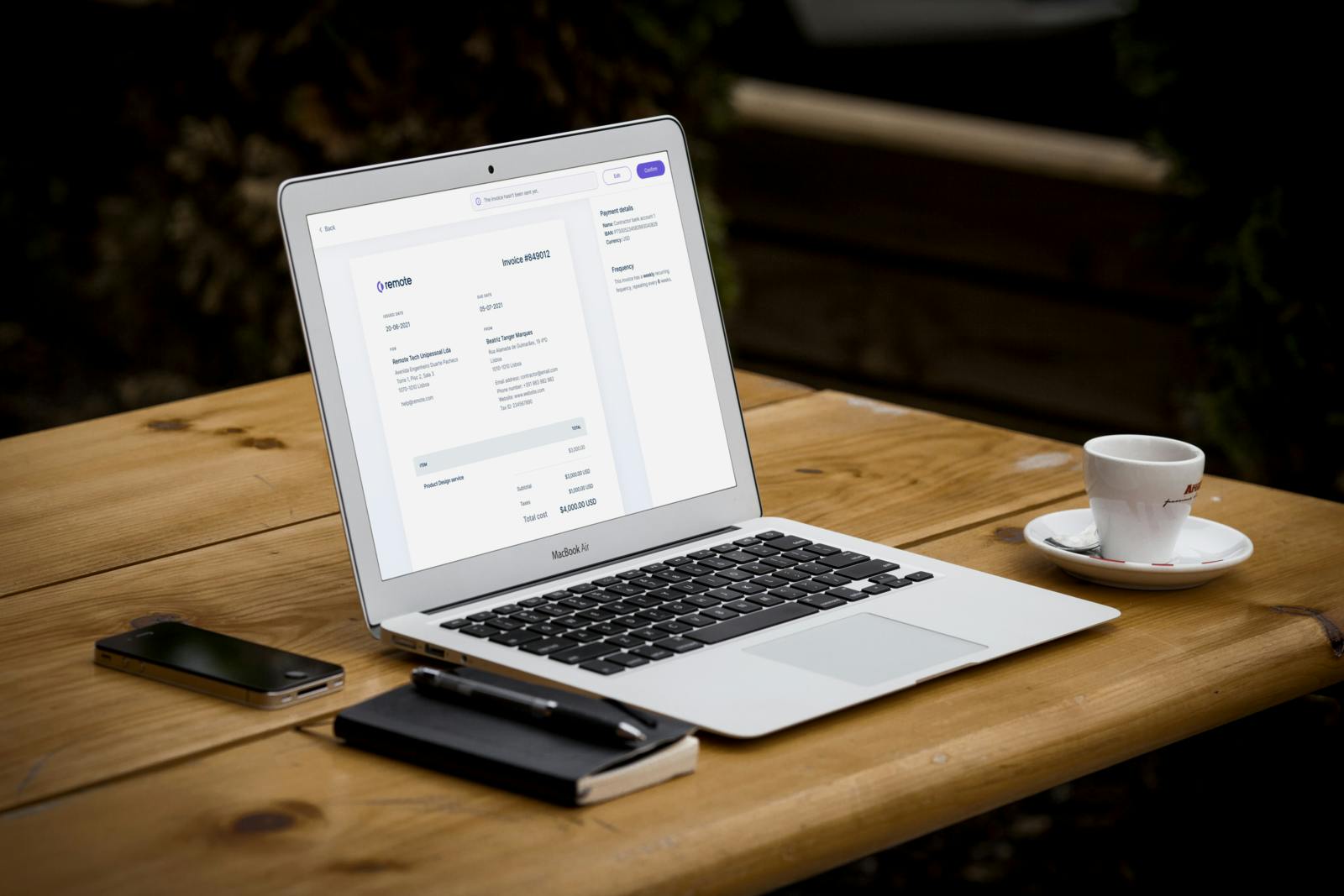
Global HR — 12 min

Contractor Management — 8 min
As a contractor, invoicing probably isn’t your favorite part of the job. Between juggling projects and keeping clients happy, dealing with all that paperwork can be a drag.
But here’s some good news: when done right, contractor invoicing can ensure a smoother cash flow, fewer headaches, and more time spent doing what you love.
In this article, we share useful tips that’ll help you invoice like a pro. We also reveal common mistakes independent contractors make when invoicing and how to avoid them.
Writing a great invoice doesn’t have to be complicated. A few key elements can help ensure prompt payments and less hassle.
Let’s break down what to include in your invoice to make it clear, professional, and effective.
Add the word “invoice” right to the top of your document. That way, when the invoice lands in your client’s or customer’s hands, there’s no mistaking what it is.
Give each invoice a unique number, such as “001.” This is a simple way to keep track of your paperwork and helps your clients easily reference their transactions.
Include essential details, like your name or business name, address, and contact information (phone number or email). If applicable, add your business identification or tax number, too. In Australia, for instance, an Australian Business Number (ABN) is mandatory for businesses with an annual turnover of $75,000 or more.
List your client’s name or business name, address, and contact details, including their phone number or email. Additionally, if relevant, include the billing contact’s name and department for direct communication.
Mark your invoice with the date you created it. This sets the starting point for payment deadlines, such as a typical 30-day term, helping both you and your client stay on track.
Add an exact payment due date to the invoice, including the day, month, and year. This offers much more clarity than saying, “due in 30 days” or “due on the first day of the month.”
While it’s not a must, a clear due date nudges your clients to pay on time and helps both sides manage their finances smoothly.
In your invoice, clearly list every service you’ve provided. This should include a description of each service, how many hours were involved or the quantity delivered, the rate charged, and any materials used — with a subtotal for each item.
A well-detailed list helps prevent misunderstandings about what was promised and what was delivered, making it less likely that your invoice be rejected.
At the bottom of your invoice, make sure to indicate the total your client owes, including taxes and any discounts. This is your invoice’s final, all-important number.
Is your business required to collect taxes? If so, make sure your invoice clearly shows the tax amount and rate.
For instance, in the UK, if your business’s taxable turnover is over £85,000, you’ll be on the hook for Value Added Tax (VAT). This means adding VAT to your prices and including it on your invoices.
In Australia, if you’re turning over $75,000 or more ($150,000 for non-profits) or running a taxi or ride-sourcing service, you need to register and include the Goods and Services Tax (GST) in your prices.
It’s not just about good bookkeeping — it’s about meeting legal standards. Stay in the loop with your area’s tax laws to ensure your invoices are up to scratch and legally sound.
Let your clients know exactly how and when you’d like to be paid. Offer a variety of payment options, like bank accounts, PayPal, Stripe, checks, or credit cards. Don’t forget to add a handy payment link, too, if you have one.
Got a late payment policy? Mention that, too. The easier it is for your clients to pay, the faster you’ll typically get your payment.

Found mistakes in your invoices? We’ve all been there. But let’s change that.
Here are some handy tips to help keep your invoicing error-free and your cash flow healthy:
Accurately tracking your hours is the foundation for fair and transparent billing.
There are many ways to track your time, including:
Jotting the hours you spend on each project into a notebook or spreadsheet
Blocking out the time you spend on tasks in a digital calendar
Logging your hours on a mobile app
Using time-tracking software
Be consistent with the method you choose to prevent confusion and help ensure invoice accuracy.
When you’re billing for both labor and materials, it’s crucial to get your pricing right. You want to cover your costs, keep your cash flow healthy, and avoid missing out on tax deductions.
Here’s a straightforward plan:
Record each piece of material you use for your job.
Add a fair mark-up to cover the time and effort of getting those materials.
On your invoices, clearly list the materials and their costs. This shows your clients exactly where their money is going.
Material prices can change, so adjust your rates accordingly.
This transparency not only helps ensure you’ll be properly compensated but also allows you to build trust with your clients.
Send your professional invoices out immediately — keeping in mind that “immediately” can vary depending on your industry. It could mean right after you’ve wrapped up the work, on a set date, like the start of the month, or as soon as you sign off on a project.
Sending out your invoices promptly keeps your cash flow healthy and sets clear expectations about payments. Plus, it shows you’re on the ball and serious about your business, which can encourage your clients to be prompt with their payments.
Sticking to one invoice format simplifies things for everyone. It helps you and your clients quickly spot what they need.
Here’s how to nail this task:
Choose a clean, easy-to-read template, and stick with it for all your invoices.
Number your invoices chronologically.
Always include the basics, such as your business details, client info, what you did, and payment options for the client.
Consistency is key, as it reduces confusion and keeps your billing process smooth.
Don’t forget to spell out the payment terms on each invoice. This a simple step, but clear terms mean fewer mix-ups and a smoother cash flow.
Missing this detail can lead to late payments and confusion, potentially causing tension with clients and making it tough to manage your finances. Be sure to detail due dates and payment methods to keep things running smoothly.
Chasing late invoices? This is key to keeping your cash flow healthy, but don’t wait too long to do it. Reach out politely a few days after the due date instead of waiting weeks.
Adopting a friendly, professional approach can make all the difference. It not only keeps the relationship with your client positive, but it also often leads to quicker payment.
A kind and clear reminder isn’t just good manners — it’s smart business.
Spice up your invoices by adding a personal touch. Pop your logo onto your invoices for a stylish addition that helps clients instantly recognize and remember your brand.
And let’s not overlook the power of a personalized note. A simple “thank you” or a custom message in the notes section of your invoice can really show your clients you value them.
This personal touch cements your reputation for being attentive and dedicated. It’s these small details that can set your business and personal brand apart.
Make paying you a breeze by offering multiple payment options. After all, the easier it is for your clients to pay, the faster you’ll get your money.
Here are some payment methods that are popular with independent contractors:
Checks
Bank transfers
Electronic funds transfer (EFT)
PayPal
Stripe
Credit/debit cards
Venmo
Apple Pay
Google Pay
Some contractors even accept cryptocurrencies.
By catering to different payment styles, you’re not just speeding up your cash flow; you’re also showing your clients you value their convenience — which is always good for business.

Encountering tricky invoicing scenarios? Whether it’s multi-currency invoicing or sorting out disagreements, these situations can be a bit of a puzzle.
But there’s no need to worry. We’re here to show you how to navigate these situations confidently so that your invoicing stays on point.
Handling invoices for international clients?
Navigating different currencies doesn’t have to be a headache. Here are some tips to keep things smooth:
Use multi-currency accounting software programs, like Xero or QuickBooks. They’re a real lifesaver for managing different currencies.
Be aware of international transfer fees, and factor them into your pricing.
Don’t forget about time zones and local tax laws. Staying compliant is crucial.
For hassle-free transactions, platforms like PayPal or Stripe are great go-to options.
To make things even easier for yourself (and your client), use a global HR platform like Remote. For contractors, you get paid in your preferred currency without fussing over exchange rates. And for those hiring, Remote lets you pay global talent in their chosen currency while keeping everything compliant, no matter where they are.
When invoicing disputes pop up, the best approach is to stay cool and communicate clearly.
Here are some tips for doing just that:
Go through the invoice together with your client. This often clears up any mix-ups.
If you’ve made a mistake, own up to it and fix it ASAP. Honesty builds trust.
If the issue is about the work being done, your contract is your best friend for clarity.
A quick call or meeting can often sort things out quicker than a string of emails.
If all else fails, mediation or legal advice might be needed.
Remember, maintaining a good relationship with your client is important, even when you’re sorting out these bumps.
If you’re a business that works with contractors who invoice, here’s what you need to know:
First, nail down a solid contract. The contract should clearly spell out the job details, payment terms, and deadlines. Make sure both sides are on the same page, as this will help you dodge misunderstandings later on.
Next, review the invoice. Make sure the invoice matches what was agreed upon and handle it quickly. Why? Because speedy reviews lead to timely payments, and that’s essential for maintaining a great rapport with your contractors.
Finally, don’t forget about taxes. Each country has its own rules, and missing the mark here can lead to some serious legal headaches. Staying on top of these details is a must for working seamlessly with contractors, no matter where they are.
Adding invoicing to your list of endless admin tasks and wishing there was an easier way — we’ve all been there. But with the right approach, contractor invoicing can be less of a chore. Your first step is to pick a tip from this guide and implement it today. Just one change can set off a chain reaction of efficiency and a smoother financial flow.
But what if you’re a business owner managing contractors? If so, you’re in luck because Remote makes contractor management a breeze. Our all-in-one platform streamlines automated, multi-currency payments, and we’ve got the expertise to handle all the tax and legal stuff.
Whether you’re a contractor or an employer, we’re here to help you thrive.
Get started with Remote Freelancer Hub and manage your clients, contracts, payments, and invoices easily in one place.
Sign up with Remote for locally compliant contract templates at just $29 per contractor per month, with no hidden fees.
Subscribe to receive the latest
Remote blog posts and updates in your inbox.